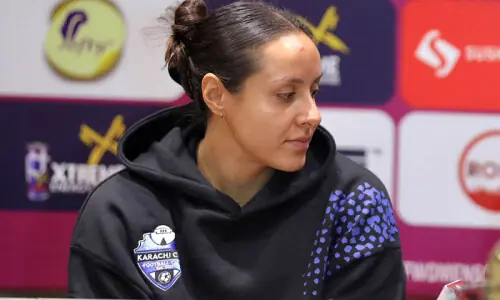Every year, the month of Ramazan brings out hordes of young boys for night cricket tournaments on streets across the country. As the lights turn on, the makeshift wickets are arranged and the frenzy begins, bowlers are seen running in and once again rekindling an old national romance that keeps on giving: Pakistanis and fast bowling.
There is a strange, beautiful connection between Pakistan and fast bowling.
For decades, the country mesmerised the world with its pacers. From Fazal Mehmood to Junaid Khan, generation after generation, Pakistan stamped its authority in the field of cricket via its speedsters.
During the '50s, the trio of Fazal-Kardar-Khan Mohammad demolished the best of the batting lineups. In the following years, Sarfraz Nawaz revolutionised death-overs bowling with his reverse swing. Imran Khan in the '80s, championed the art of reverse swing bowling, and sent plenty of stumps cartwheeling in the death-overs.
Yet, there was a basic ingredient of fast bowling that was missing in this era, barring Imran – genuine pace.
Nonetheless, by the late '80s, Pakistan had championed in this department as well, and from then onwards, it produced some serious pace generators.
This was the same time when Pakistan’s school cricket was taking a fall and tape-ball cricket was on the rise. The origins of tape-ball cricket are unclear, however, a large proportion concludes that it initiated from Karachi’s densely populated area of Nazimabad.
Also read: Revive school cricket to rescue Pakistan
In the '70s, Karachi’s street-cricket became so popular that street cricketers got the same level of respect as Test cricketers. Nadeem Moosa was one such celebrated street-cricket legend. The left-arm spinner played First-class cricket for four years, from 1983 to 1987. His ordinary 29-match stint bagged him just 30 wickets before he permanently settled for tennis ball street-cricket.
Soon, the average First-class cricketer caused havoc in the street circuit after he found his lethal weapon, the ‘finger spin’. Moosa, a left-arm tennis ball quickie, discovered the spin as he and his friends tested each other’s ability to spin the tennis ball. Moosa squeezed the ball between his middle-finger and thumb and flicked, upon release, the ball generated a sharp turn with bounce and pace.
“It used to land well outside off-stump and then come in very sharply,” says Moosa in Osman Samiuddin's 'The Unquiet Ones'.
With his innovation, Moosa became the most fearsome bowler in the city and the reason for tape-ball cricket invention. He claims, “It used to break so much you couldn’t even try to play it.”
In Nazimabad Three, a frustrated opposition came up with the idea of wrapping electrical tape on the tennis ball to make it difficult for Moosa to squeeze the ball.
“I think, in an attempt to stop our team, they said, let’s put some tape on to counter his finger,” he says.
Moosa’s art died a sorrowful death. However, the notion of wrapping tennis balls with electrical tape spread throughout the country like wildfire.
Explore | Street cricket in Pakistan: A personal history
The idea gained popularity among fast bowlers and batsmen, as taped tennis balls faced less air resistance and travelled quickly. This allowed pacers to bowl faster and batsmen to hit massive hits.
By the start of the last decade of the 20th century, tape-ball cricket had spread throughout the country. The absence of cricket at school attracted young cricket frenzies towards parks for tape-ball matches. These parks wore the look of Lahore’s famous Race Course Park on the occasion of Basant (during the good old days) every evening except, kites were replaced with tape-balls.
This blissful eruption of a new form of cricket gave rise to fast bowling in muhallas (neighbourhoods), since bowling quick used to be the only way of escaping the batsman’s wrath. “Jarr mein maar” (‘hit the base of the stumps’) became the most usual order, which helped the bowlers to master yorkers, as there used to be no margin for error. Every missed yorker was hit many a mile.
However, the most fun development was that the smallest scratch on the tape provided the ball with miles of lateral movement in the air, which allowed cricket frenzies to try and emulate their heroes’ reverse swinging yorkers.
Fast bowling is all about the quick contraction and relaxation of the muscles.
The tape-ball, which weighs much lighter than a cricket ball, allows rapid muscle movements. The quicker the arm rotates, the faster the ball travels. Thus, bowling with the tape-ball in their muhallas enables young cricket enthusiasts to develop fast-bowling muscles from a very early age. That is why bowlers who emerged after the mid-80s were pacier than their predecessors.
Wasim Akram, Shoaib Akhtar, Mohammad Sami, Umar Gul, Sohail Tanvir, Mohammad Amir, Junaid Khan, are products of tape-ball cricket. All of these bowlers have impressed the cricket fraternity with their extraordinary pace (okay, maybe everyone except Tanvir).
Also see: Trending Pakistan's street cricket
Back in the day, Wasim Akram's weapon in knocking stumps out of the ground all over Lahore, was the tape-ball. He continued to do so till 1983, two years before his Test debut in New Zealand.
Umar Gul, who is said to have played tape-ball cricket for the longest of all, proved to be one of the best death-overs bowlers. His sharp full length in-dippers in the latter part of the innings made him stand out in the 2009 World T20, which Pakistan went on to win. Gul once revealed that he had not held the cricket ball until as late as the age of 16.
Ace bowler Mohammad Amir was scouted at the age of 13 during a tape-ball tournament.
All in all, tape-ball cricket certainly benefited Pakistan’s fast bowling, though it has had an equally negative impact on the batting department. It has destroyed our batsmen’s feet-movement and their wrist-work. But, more on that some other day.
For now, let us take a look around us at all the Ramazan night-cricket tournaments happening these days, and thank street cricket for adding genuine pace to Pakistan's fast bowling arsenal.




































